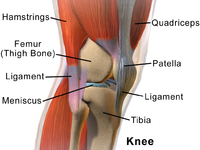
Photo from wikipedia
Background No studies have directly evaluated kinematic changes during squatting before and after bicruciate-stabilized total knee arthroplasty (BCS-TKA) with the dual cam-post mechanism and asymmetric surfaces. This study investigated the… Click to show full abstract
Background No studies have directly evaluated kinematic changes during squatting before and after bicruciate-stabilized total knee arthroplasty (BCS-TKA) with the dual cam-post mechanism and asymmetric surfaces. This study investigated the effect of BCS-TKA on changes to pre- and postoperative skeletal knee kinematics, to identify factors associated with postoperative skeletal kinematic parameters. Methods Seventeen knees in 17 patients were prospectively recruited before primary TKA for advanced medial knee osteoarthritis. Subjects underwent BCS-TKA and were evaluated more than 1 year postoperatively. In vivo dynamic skeletal knee kinematics were evaluated using periodic radiographic images collected during squatting to quantify the tibiofemoral functional extension/flexion angle, anteroposterior (AP) translation, and axial rotation angle using image-matching techniques. Rotational alignments of femoral and tibial components were measured postoperatively using computed tomography images. Results The pre- and postoperative tibiofemoral functional extension/flexion angles during squatting were 12.2° ± 6.7°/100.1° ± 16.8° and 9.6° ± 8.6°/109.4° ± 16.8°, respectively, with a significant difference in flexion angle ( p < .05). Total AP translation was significantly larger postoperatively than preoperatively (10.8 mm ± 3.7 mm vs. 14.4 mm ± 4.2 mm, respectively; p < .05). The pre- and postoperative total rotation angles were 6.6° ± 3.0° and 6.4° ± 3.7°, respectively, indicating no significant difference. The pre- and postoperative tibiofemoral functional flexion angles were significantly associated with each other ( p = .0434, r = .49). The postoperative total rotation angle was significantly smaller when the total component rotational mismatch angle between the femoral and tibial components was above 5° vs. below 5° (4.6° ± 2.7° vs. 8.3° ± 3.9°, respectively; p < .05). Conclusions BCS-TKA significantly increased the tibiofemoral functional flexion angles, with larger AP translation postoperatively. Both preoperative skeletal kinematics and surgical techniques affected the skeletal kinematics of the replaced knee. A total component rotational mismatch angle greater than 5° significantly decreased postoperative total knee rotation during squatting.
Journal Title: BMC Musculoskeletal Disorders
Year Published: 2021
Link to full text (if available)
Share on Social Media: Sign Up to like & get
recommendations!